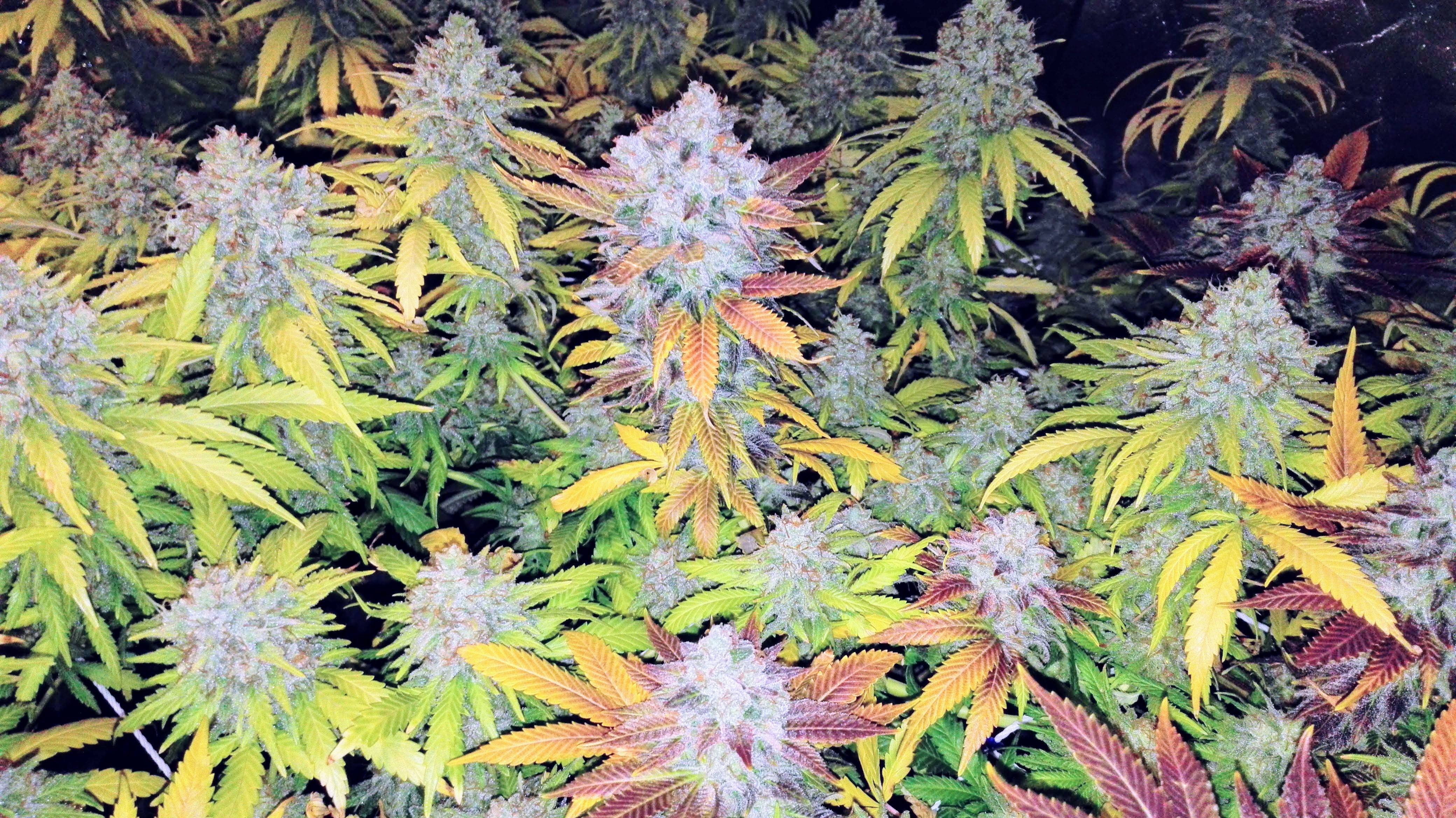-
Posts
1,019 -
Joined
-
Last visited
-
Days Won
1
Content Type
Profiles
Forums
Calendar
Gallery
Articles
420 Directory
Classifieds
Everything posted by Toby
-
Thanks bud. Im the picture HSO Blue Dream & Totemic Chocolope Kush cross. 12-1 FTW
-
Thanks, after doing some more research, it does look like symptoms of light burn. Some of the taller buds are bleaching. I cant raise my hood any higher due to space limitations. This grow's scrog went crazy. Lesson learnt. Keep canopy in check.
-
HI guys, I need your assistance in identifying what the problems are and how to correct it. My plants are about 3 weeks away from harvest. The problem is only on the one plant. Have been following the same regiment for all of them. My medium is organic. I would appreciate your input. See images below.
-
Welcome to the community. Im sure you will learn alot here. Enjoy your stay.
-
Nice going, they looking tasty. @Hertzzz here are some suppliers hydroponic.co.za GThydro
-

10 000 Watt Super Grow !!!!!! Blue Cheese, Sensi Star, AK47
Toby replied to a topic in Starting Your Own Grow
Is this your 20 000 watt grow? This must been one of he best grows i have ever seen before... -

10 000 Watt Super Grow !!!!!! Blue Cheese, Sensi Star, AK47
Toby replied to a topic in Starting Your Own Grow
wow thats one big ass setup, lol -
Yeah man, research and identifying your needs before committing to anything is your best bet. I grew virtually for about a year, exploring various grow and training techniques. Till i found what will work for me in my situation. From there you fine tune your formula to get the best possible results. Good luck
-
check out the cabinet & cupboard section. The guys have come with some very innovative cost effective ideas.
-
Remember more light more heat. You will need proper ventilation in order to regulate temp & humidity. The size of your space plays an important role in determining how much is enough?
-
Welcome to community bud. Enjoy your stay
-
Nice going excellent stuff, reminds me of home, lol Enjoy bud
-
here are some place to acquire HydroherbAfrica GTHydro Hydroponic.co.za
-
Dont be so hard on yourself. Educate yourself, read whatever you can find. All the info is out there. Cannabis plants are tough, they can take alot. So dont fret over the small things. Here are some awesome sources of info. Some E-Books Organics - The GLO way Grow Weed Easy
-
I would suggest repotting to ensure proper drainage. I simple Styrofoam cup with a couple of holes at the bottom until you have nice root-ball before transplanting into larger container. It will alleviate potential problems, IMO .
-
Does that container have holes in the bottom for drainage?
-
This is from the Joe Pietri files. Why does 6 on 18 off work so well? JOSEPH R. PIETRI [ltr]Why does 6 on 18 off in flower work? Cannabis can only uptake 6 hours of light energy for photosynthesis, its tanks are full, when you give it more light energy, the plant goes into photosynthesis protection, which use up energy and shuts down CO2 intake. So now you are using the energy received to its utmost potential, no energy wasted, no CO2 shutdown, the plant now has 18 hours to grow fatter buds and produce more resin than ever before. 6 on 18 off in flower is the game changer. All they ever taught you was to spend thousands to make hundreds. 12-1 6-18 is direct aid to all growers. Fuck the status quo.[/ltr] Some more info 6 hour finish By Joseph R. Pietri Since the dawn of time, farmers have understood the role of light in plant growth; it wasn’t until the beginning of the twentieth century that we began to understand the importance of darkness. In 1913, the French graduate student Julien Tournois discovered that hops and hemp grown under glass would flower precociously in winter. He also observed that the plants would flower most rapidly when allowed only six hours of daylight[1]. Tournois’s research ended when he died on the front during World War I, but a few years later two American scientists, Wrightman Garner and Harry Allard, unwittingly expanded upon Tournois’ findings. Wrightman and Allard discovered that certain plants bud more readily when they sense a change in seasons, or rather: Certain plants will begin to bud when they sense a change in the ratio of daylight hours to nighttime hours. Garner and Allard immediately saw the implications for agriculture. They began experimenting on a range of plant species and discovered that day length influences many aspects of plant activity, including dormancy, flowering, and potential yield[2]. In 1920 they noted: “under the influence of a suitable length of day, precocious flowering and fruiting may be induced[3].” Garner and Allard invented a word to describe a plant’s sensitivity to day length: Photoperiodism. Photoperiodism is a biological response to a shift in the proportions of light and dark in a 24-hour cycle. Photoperiodic plants measure hours of darkness in order to keep track of the seasons and thus flower at an appropriate time of year. The two scientists began classifying plants as long-day plants (LDP), day-neutral plants (DNP), and short-day plants (SDP). Day-neutral plants can flower at any time of year, depending on other conditions. Long-day plants flower naturally in high summer, when the nights are shortest. Short-day plants flower naturally when the nights are long: either in early spring or in late summer and early autumn. Short-day species include chrysanthemums, poinsettias, cosmos, globe amaranth, rice, hyacinth bean, and some varieties of marigold, orchid, and strawberry; as well as and a number of other high-value specialty crops. Short-day is actually something of a misnomer: short-day plants sense darkness, not light. When sensors in your plant’s leaves indicate that each 24-hour cycle includes 12 or more hours of sustained, uninterrupted darkness, your plant’s apical meristems (growing tips) will shift priorities: instead of producing more leaves and stems, the plant will begin to produce floral structure. In Photoperiodism in Plants, Thomas and Vince-Prue expand upon the concept: ”Perhaps the most useful proposal is that of Hillman (1969), who defined photoperiodism as a response to the timing of light and darkness. Implicit in this definition is that total light energy, above a threshold level, is relatively unimportant, as is the relative lengths of the light and dark period. What is important is the timing of the light and dark periods, or, to think of it another way, the times at which the transition between light and dark take place.” Biologist P.J. Lumsden also emphasized the importance of precise timing, noting: “…photoperiodic responses require a time-measuring mechanism, to which is closely coupled a photoperception system. Further, the time-keeping mechanism must operate very precisely and it must be insensitive to unpredictable variations in the environment.” In other words: absolute darkness is not necessary to trigger a photoperiodic response in SDP, but consistency of dark-to-light ratios is essential. During a 1938 experiment on the effects of light on xanthium, Karl Hamner and James Bonner discovered that the benefits of a long night could be reduced or abolished if the darkness was interrupted for even a few minutes[4]. The converse was not true: the flowering process was not reversed when the daylight hours were interrupted with darkness. Growers of SDP crops have been using light deprivation research to their advantage for decades. For example, poinsettia farmers use automated greenhouses to ensure that plants bloom for the Christmas season. More recently, light deprivation technology has caught on in other specialty gardening industries. Light deprivation is an ideal method for farmers who want to bring a crop to market before the market floods during the harvest season. The method also allows farmers to avoid potential rain damage by harvesting when weather conditions are ideal. Perhaps more importantly, light deprivation offers the opportunity to plant and harvest twice during one growing season and thereby double annual yield. To utilize light dep, farmers plant crops in hoop houses or greenhouses, which are covered with opaque material for a period of time each morning or evening. The goal is to block sunlight and increase the number of hours the crop spends in darkness: more than 12 hours of darkness will stimulate flower growth in most SDP plants. The challenge is to keep the schedule consistent and to ensure that the darkness is not interrupted, either by unseen rips in the covering, shifts in the covering caused by wind, or human error. As Hamner and Bonner demonstrated, interruptions or inconsistencies in the light deprivation cycle can confuse the plant and slow flower growth. If it works it works, if not I have learnt it doesnt work.
-
Shot bud. Glad I could help. I am keeping logs and comparing every 10 days to check the differences. So far i cant see physical differences, I hope the buds are nice and solid and not airy, but ja experiments are fun when the work out,lol
-
Cool man. I cant take credit for the light cycle. Joe Pietri's technique. I have since changed my light cycle to 6 hrs on and 18 hrs off from day 1 of flowering. I will see how it goes.
-
Cool man, they progressing nicely. When you say you changed the light cycle again? What cycle was it on and to what did you change it?
-
Looking good there CK. What day she at now and how long to go?
-
In my personal experience when repotting seedlings is to repot into an intermediate pot and then again into the final pot a few weeks later when a nice rootball has been established. Its easier to manage IMO. Less issues to deal with
-
Hi Hertzz, Welcome to the community, im sure you will learn alot here. If you interested in the scrog method. Have a read here
-
I have ordered from Bonza seeds. Excellent customer service and great variety. I took advantage of their special on boxing day (40% off) and told them to dispatch the goods on the 16/01/2017. I get daily updates on my order which is cool. Its should be in 4 days according to their report. Im in Cape Town so this me hoping for the best. I know other members here who ordered from them, based in Cape Town, had deliveries with no issues. Ill let you guys know when I receive them.
-
Plant your seedling deeper than normal if you feel its to stretchy, IMO. It should be fine moving forward. Good luck




